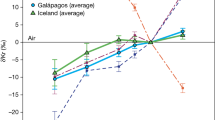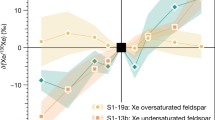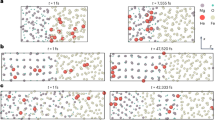Abstract
I REPORT here some radiogenic 4He and 40Ar data measured in the glass margins of deep sea pillow basalts, and comment on their applicability to discussions of formation of the Earth's atmosphere by degassing from a solid Earth. Discussions of such degassing generally assume either catastrophic or continuous degassing (see refs 1, 2 and references therein). In fact, there is no reason why these two sets of models should be considered to be mutually exclusive. The history of the Earth may include both a catastrophic event with an associated ‘big burp’, and later continuous degassing.
This is a preview of subscription content, access via your institution
Access options
Subscribe to this journal
Receive 51 print issues and online access
$199.00 per year
only $3.90 per issue
Buy this article
- Purchase on Springer Link
- Instant access to full article PDF
Prices may be subject to local taxes which are calculated during checkout
Similar content being viewed by others
References
Schwartzman, D. W., Geochim. cosmochim. Acta, 37, 2479–2496 (1973).
Ozima, M., and Kudo, K., Nature phys. Sci., 239, 23–24 (1972).
Ozima, M., Nature phys. Sci., 246, 41–42 (1973).
Funkhouser, J. G., Fisher, D. E., and Bonatti, E., Earth planet. Sci. Lett., 5, 95–100 (1968).
Noble, C. S., and Naughton, J. J., Science, 162, 265–267 (1968).
Dalrymple, G. B., and Moore, J. G., Science, 161, 1132–1135 (1968).
Fisher, D. E., Earth planet. Sci. Lett., 14, 255–258 (1972).
Kirsten, T., and Gentner, W., Z. Naturforsch, 21 a, 119–126 (1966).
Gramlich, J. W., and Naughton, J. J., J. geophys. Res., 77, 3032–3042 (1972).
Wasserburg, G. J., Mazor, E., and Zartman, R. E., Earth Science and Meteoritics, (edit. by Geiss, J., and Goldberg, E. D.), 219–240 (North Holland, 1963).
Wakita, H., Nagasawa, H., Uyeda, S., and Kuno, H., Geochim. J., 1, 183–198 (1967).
Fisher, D. E., Geochim. cosmochim. Acta, 34, 630–634 (1970).
Green, D. H., Morgan, J. W., and Heier, K. S., Earth planet. Sci. Lett., 4, 155–166 (1968).
Fisher, D. E., Earth Sci. Revs (in the press).
Fisher, D. E., Geochim. cosmochim. Acta, 36, 15–39 (1972).
Schwartzman, D. W., Nature phys. Sci., 245, 20–21 (1973).
Fisher, D. E., Geophys. Res. Lett., 4, 161–164 (1974).
Oversby, V. M., and Ringwood, A. E., Nature, 234, 463–465 (1971).
Author information
Authors and Affiliations
Rights and permissions
About this article
Cite this article
FISHER, D. Trapped helium and argon and the formation of the atmosphere by degassing. Nature 256, 113–114 (1975). https://doi.org/10.1038/256113b0
Received:
Accepted:
Issue Date:
DOI: https://doi.org/10.1038/256113b0
This article is cited by
-
Formation and Evolution of Protoatmospheres
Space Science Reviews (2016)
-
Constraints on evolution of Earth's mantle from rare gas systematics
Nature (1983)
-
Mantle plume noble gas component in glassy basalts from Reykjanes Ridge
Nature (1983)
-
Rare gases from the undepleted mantle?
Nature (1983)
-
K, U and Th in mid-ocean ridge basalt glasses and heat production, K/U and K/Rb in the mantle
Nature (1983)
Comments
By submitting a comment you agree to abide by our Terms and Community Guidelines. If you find something abusive or that does not comply with our terms or guidelines please flag it as inappropriate.



